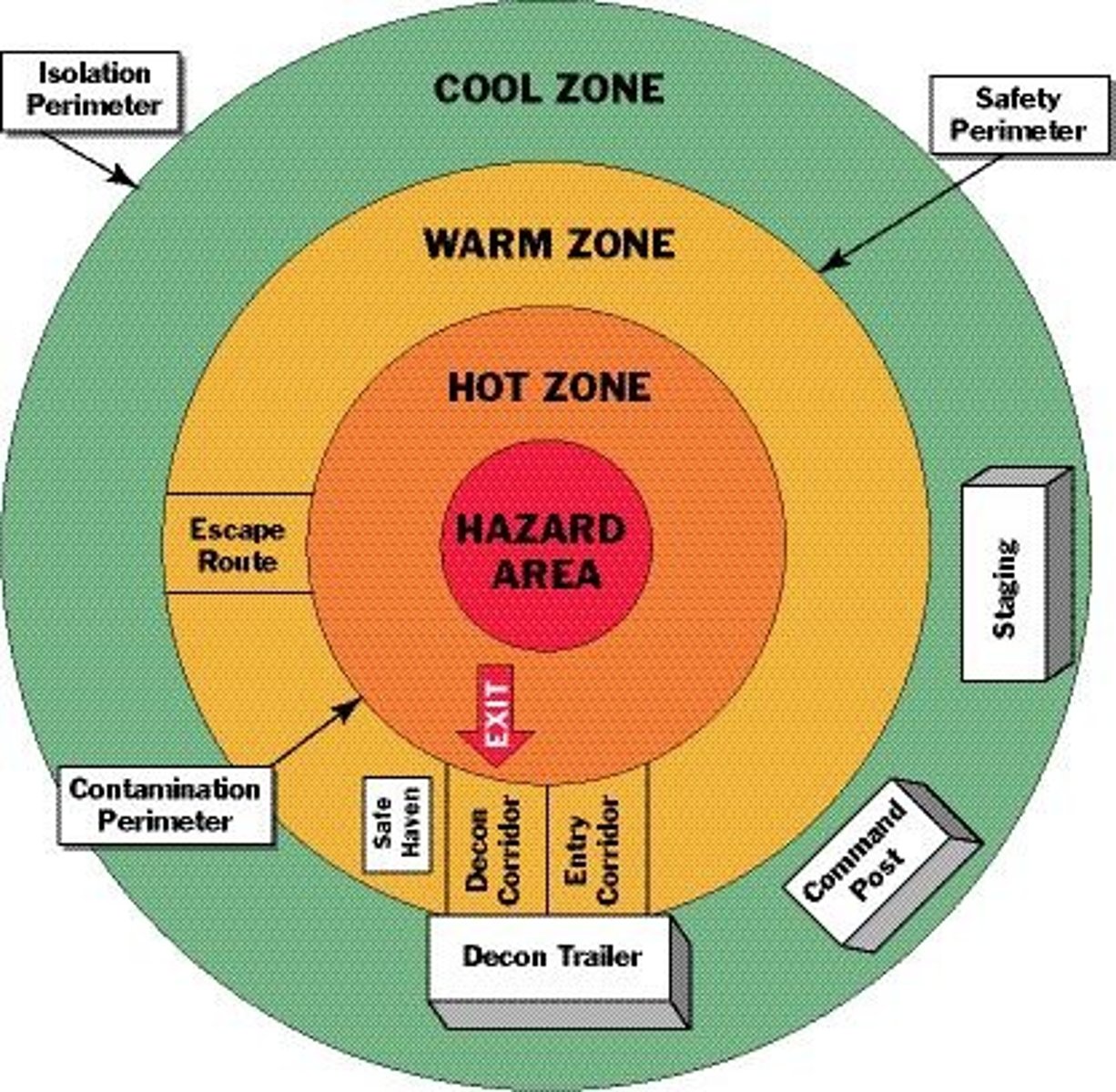EMER 108 LO2 Establish a Safe Work Environment by Assessing the Scene for Safety and Addressing Potential Occupational Hazards
1/19
There's no tags or description
Looks like no tags are added yet.
Name | Mastery | Learn | Test | Matching | Spaced |
|---|
No study sessions yet.
20 Terms
Situational Awareness
the need or ability to have a high level of attentiveness to the environment in a dynamic situation or making the proper decision and acting on it in the most appropriate fashion.
Knowledge and understanding of your surroundings and situation and the risk they potentially pose to your safety or the safety of the EMS team.
What are some risks at MVC and rescue scenes?
Unstable vehicles
Moving traffic
Jagged metal and broken glass, debris
Fire or explosion hazards
Downed power lines
Toxic substances
When you approach a vehicle on the side of a road and you have limited information on the situation what 3 rules should you follow?
Park 5 meters away with a clear exit.
Before leaving your EMS unit report to dispatch situation info and license plate number.
At night use high beams and spotlights.
MVC/MVA
Motor Vehicle Collision/Motor Vehicle Accident
Toxic substances can cause injury or illness if exposed to it without the proper PPE.
Lawn and garden chemicals
Industrial and manufacturing chemicals
Smoke
Proper body and respiratory protection
Infectious diseases
Unstable/Unpredictable Structures, Surfaces, and Environments
Actions you can take to help minimize the risk in those situations:
Consider retreating to your rig until the scene is secured and deemed safe.
If you believe you can pull it off safely, remove the patient from the scene with you.
Be cautious of the unknown calls or the "man down" calls. If you have any reservations about entering a scene "stage" and wait for law enforcement to assess the scene first.
Weather, terrain, lighting, environment, and structures can also become hazards to you and your patients from the following components:
Weather: snow or ice covered surfaces, rain, or storms
Terrain issues: mud, rocks, etc.
Illumination difficulties: nighttime, power outages
Difficulty accessing scene
2
Unstable structures, surfaces, or environments - may be buildings, vehicles, work sites, etc.
Domestic violence
Among the most dangerous situations.
If a violent or physical dispute is in progress, do not enter. Stage and wait for law enforcement to secure the scene. If already on-scene, retreat with patient as soon as possible if safe to do so.
1 in 4 women who go to the ER have complained of domestic violence
.Good communication with appropriate body language can help defuse a potentially violent situation.
EMS being confused with law enforcement personnel
Patients and bystanders mistake paramedics for police officers - similar uniforms
Aggressive behavior intended for the police
Options for self-defense limited
Violence can often be predicted. What to watch for:
Blank or "thousand mile" stare
Clenched fists
Verbal threats
Heavy breathing
Sweating
Gangs operate on their own "three R's"
reputation, respect, retaliation.
Two ways that you can identify hazardous materials:
Informally and formally.
Informal product identification should be used only as a temporary means to determine the presence of any hazardous material.
A product should always be identified formally before any activity that may pose a threat to the safety of all of the emergency responders is undertaken.
Body Substance Isolation (BSI) protocols and standard precautions
Properly sized gloves should be worn on every call.
If blood or other fluids could potentially splash, wear eye protection.
If inhaled particles are a risk factor, wear a properly sized and fitted mask.
It is always better to err on the side of caution.
Vehicle Positioning and Traffic Safety
One common method is the Fend-Off Position
Pull as far to the right or left (depending on the flow of traffic and the location of incident) as possible, then turn to position your vehicle at an angle of 20 to 30 degrees. This provides greater visibility of the side of the emergency vehicle to approaching motorists and may also serve to deflect any high-speed impact that could otherwise crash into the scene. Create a "buffer zone" of approximately 4 meters for every 10 km/hr of the posted speed limit between the vehicle in the Fend-Off Position and the incident site.
When dispatched to a scene involving hazardous materials, decisions must be made early regarding:
Rescuer safety
Type and degree of the potential hazard
Involvement of other agencies.
Pre-planning and early coordination is imperative
Advise medical direction early
HazMat Scene Management
Establish 'Safety Zones'
Notify dispatch immediately
Identify and report wind direction and terrain features
Approach upwind and uphill
Always follow the 'Rule of thumb'
Isolate the incident as much as possible and restrict access to those that should not enter
Call for additional resources (Hazmat team, fire department, police, additional crews)
"zones" to deal with HAZMAT.
Red or Hot (contamination) zone
PPE
Yellow or Warm (Control) zone
PPE
Green or Cold (Safe) zone

Standard decontamination processes are:
Unless the substance is identified, decontamination should begin by: -Brushing off the powder
-Flushing the skin with copious amounts of water
Never attempt to neutralize an acid or base
-Doing so can produce great heat and cause further burns
Flush the area copiously with water
Transport
What is the most concern at any EMS scene?
Your own safety and the safety of EMS team members
If you arrive on scene and a violent or physical dispute is in progress what should you do?
Stage and wait for law enforcement to secure the scene. If already on-scene, retreat with patient as soon as possible if safe to do so.